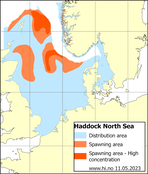Haddock in the North Sea, Skagerrak and west of Scotland

The North Sea haddock spawns between March and May in the central parts of the North Sea. Nurseries are coastal areas of the Morray Firth, around Orkney and Shetland islands, and along the edge of the Norwegian continental shelf (Eggakanten) at about 200 m depth, from Shetland to Skagerrak.
Haddock produces very strong year classes that can dominate catch and population over several years. Unlike cod, haddock in the North Sea grows much slower than in the Barents Sea. Despite this, the North Sea haddock is sexually mature earlier, around two to three years old. It is then about 28 cm long. At the age of five, it reaches length of 38-45 cm.
Haddock is a typical demersal fish. It eats mainly benthic animals such as polychaetes , clams and ophiuroids, but sandeel and herring eggs are also on the menu. Over the last 50 years, the distribution of North Sea haddock has changed. Haddock was, in the past, extending as far as to the south of the North Sea, but nowadays, most of it is found north of a line drawn between Newcastle and Hanstholm, DK.
Fisheries
Haddock is mainly caught with a bottom trawl, and to a lesser extent also with Danish seines. Haddock is a target species for parts of the fishing fleet but is also caught in mixed fisheries along with cod, whiting and Norwegian lobster, among others.
Published: 18.12.2018 Updated: 23.08.2023

